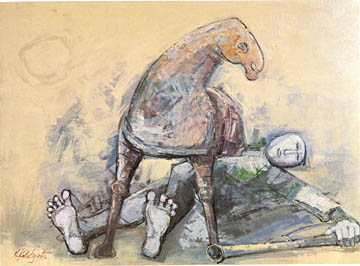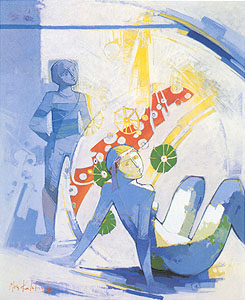
STRIVINGS IN THE ART OF MENELAOS KATAFIGIOTIS
By Chrysanthos Christou
Professor at the Universities of Athens and Thessaloniki, Art Historian and Critic.
Menelaos Katafigiotis is one of the artists who emerged from the mid World War II generation. He was born in the plains of Thessaly and graduated from the School of Fine Arts of Athens, and has been working abroad for many years. There is no doubt that he gives his utmost for an art which synthesizes the established prototypes and new ideas in one unity. One can realize that his artistic beginning and his dealings with contemporary world's problems go back to his childhood. His expressive language is distinguished in terms of clarity, chromatic intensity and dynamics.
In his works of the last few years, Katafigiotis attempts to combine expressionistic tendencies and surrealistic subjects with chromatic unity and symbolisms. The surface of his paintings can be captured in most cases as a conversation between the figures and the areas with a courageous expressive tongue in every extension.

His idea of painting manner human figures and horses in different scale no doubt originates in his childhood (something exceptionally big, the horse, lives in the small child). The childish existence does not limit his description. His paintings are full of symbolism and are accented by the enormous chromatic strength and abstract space of the area.
Using visual reality as a starting point and the positive as a basis, unity of figures is developed on the paintings. These figures are distinguished by their shape and independent color. In all of his attempts we have a combination of austere geometric shapes with the free flowing organic forms: The small and the large, the horizontal with the vertical and diagonal, the exterior with the interior.
As an expressionist of form rather than of color, Katafigiotis antithesizes extreme disfigurement and restrained chromatic tones with large exterior gestures, resulting in an exceptional expressive force.
Along with Katafigiotis' expressionistic attempts we have another set of works, which is distinguished by its Byzantine form and its lyric content. In this category the main topic is mother and child where the figures are soft with subdued colors and with an undefined interior shape. In details, like the expression of the eyes and the united but undefined space, one can see Katafigiotis' preoccupation with the Byzantine art. But parallel to this, the general elements and the abstract characteristics show his familiarity with his contemporary search.
In another dreamy environment we are transformed to a third group of his work, which is painted with new plastic colors that permit the artist to express some of his other worried thoughts. Worked with his personal technique, the paintings of this group strongly combine a poetic and dreamy space along with some free decorative elements which transform the viewer away from his world.

As an expressionist with a touch for surrealism, Katafigiotis, in an area of more lyric painting of the mother and child theme, attempts with his new techniques and colors to move in different directions. In all of his new paintings and sketches the plastic colors give special attention to his values. This is obvious in the way the figures interact with the space and the human form, which is the dominant form in his paintings. They are loaded with interior forces and give a vibrant and expressive truth to his works.
Katafigiotis' style of painting, with its purity and expressive language, is not limited to only one area. It reveals a morphoplastic willingness, which strives to reach a definition of the world without submission to predetermined shapes. There is no doubt that in Katafigiotis we have an artist who is morphicly fulfilled with a personal language of painting which combines clarity and submitting dynamity of color with exceptional expressive extensions.
One can easily see that he draws from his childhood experiences and a contemporary view of a problematic world. His artistic value lies in clarity of form and a chromatic force.
Katafigiotis' most characteristic efforts, within the last years, is a combination of expressionistic tendencies with surrealistic manifestations, the unity of color with the allusions of symbolism.
In most cases his paintings are a conversation among his own figures, a convergence, a robust, expressive tongue replete with projections.
In this manner, there is no doubt that his childhood experiences keep emerging not merely as thematic subjects within a narrow view of the world but as vivid, revealing, varying works, ringing with multi-colored symbolism. This can be easily ascertained in his paintings of human forms and horses where upon the eyes of a child stare at a horse as something huge.
His starting point is a realistic eye, based on the concrete, a surface where shapes and things move in and out in unison, retaining, at the same time their fierce chromatic independence.
Virtually, in all his artistic efforts we have a combination of austere geometric surfaces with liquid, organic themes, the small with the large, the vertical with the diagonal and the flat, the internal with the external.
An expressionist in form rather than in color, Katafigiotis relishes in antithesis: the disfigured with the elegant, the grandiose with the restrained, thus achieving an artistic power and equilibrium.
Along with his paintings of a clearly expressionistic character we have a group of paintings, distinct for their Byzantine approach and their, somewhat, lyric tone. In these works, we usually have the traditional topic: Mother and child. Here the lines are soft, the colors subdued, the surfaces innermost and hazy.
The detailed depiction of the eye, the face structure and the unified but hardly defined surface testify to Katafigiotis' early predilection with the Byzantium, while the generalized and impersonal features show his familiarization with contemporary techniques.
A third group of his paintings, of an onieric landscape, painted with bold colors, lead us to a dominion of research and introspection. These paintings have quite a personal touch and combine poetry and deliberate decoration, transporting the viewer to the painter's own world.
Expressionistic in form with elements of surrealism and symbolistic tendencies Katafigiotis moves freely into many areas as it is shown in his Mother and Child set of paintings, which are bathed in a dreamy climate touched with lyricism.
In all his paintings and his sketches as well one gets the impression of lucid forms moving freely and yet obeying an inner symmetry.
Katafigiotis' art - limpid, strong and expressive – is not restricted to one area only. It strives ardently to find an interpretation of the world through the painter's free and unfettered will.
Moreover he leaves no doubt that in him we have an artist with a wholesome personality, a distinct and eloquent language a powerful creator of colors and a projector of original expressions.
